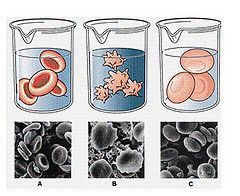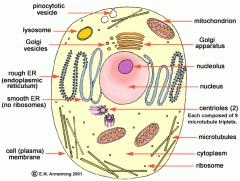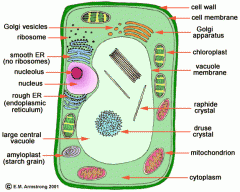![]()
![]()
![]()
Use LEFT and RIGHT arrow keys to navigate between flashcards;
Use UP and DOWN arrow keys to flip the card;
H to show hint;
A reads text to speech;
88 Cards in this Set
- Front
- Back
|
What is a solution?
|
mixture in which one substance is dissolved ( fits in b/w spaces) of another substance
|
|
|
What is the substance beinging disolved called?
|
solute ex sugar
|
|
|
What is the substance doing the dissolving called?
|
solvent
|
|
|
There are 3 types of solutions in which cells can be found name them.,
|
Isotonic solution
Hypotonic solution Hypertonic solution |
|
|
what is the universal solvent?
|
water (aqueous solution)
|
|
|
In an isotonic solution what is the concentration of solutes in and outside the cell?
|
concentration of solutes is the same inside and outside cell.
|
|
|
In istonic solution is there any movement of water?does pressure change?
|
NO movement of water and no change in pressure so no change in overall appearance of cell.
|
|
|
Concentration solute in Hypertonic?
|
concentration solutes outside cell greater than concentration of solutes inside cell.
|
|
|
What happens to cell in hypertonic solution? (pressure/water movement)
|
net movement water out from cell pressure decreases
|
|
|
what is it called when an animal cell shrinks?
|
when it shrivels/ shrinks it is called CRENATION.
|
|

what is it called when contents of plant cell move away from cell wall to vacuole?
|
Plasmolysis- cell gets soft/flaccid
|
|

What is it called when water moves into a plant cell?
|
Turgidity- cell becomes rigid
|
|
|
the concentration in a hypotonic solution?
|
concentration solutes outside cell less than concentration solutes inside cell/
|
|
|
what happens to a cell in hypotonic solution?
|
net movement water into cell pressure will increase inside cell
|
|
|
what is it callled when water moves into animal cell?
|
Hemolysis-cell explands and bursts
|
|

name the solution in a, b, c
|
Isotonic, hypertonic, hypotonic
|
|
|
why is it important for hospitals to prepare IV solutions with great care?
|
because you don't want it to undergo crenation or hemolysis
|
|
|
what is reducing sugar give 2 examples.
|
carbohydrate that contains aldehyde group and can be oxidized losses electrons to form carboxyl group ex glucose/lactose.
|
|
|
what is a negative/positive control?
|
negative control shows no chang ewhen testing agent added substance testing for absent vice versa
|
|
|
what solution do you use to test for reducing sugar? colour it turns present/not present
|
Benedicts solution-red/blue
|
|
|
what solution do you use to test for starch? colour present/not presnt
|
iodine dark blue/ orange
|
|
|
what solution do you use to test for protein?
|
Biuret Reagent blue/light purple
|
|
|
what solution for lipid?
|
Sudan III dye
top layer red bottom layer colourless/completely red |
|
|
what is a cell responsible for?
|
structure and function of all living things
|
|
|
state the 3 pts. of modern cell theory
|
1) all cells come from pre-existing cells
2) living things are comprised of at least one cell 3)cells basic structure & functional units of living things |
|
|
what are the 2 general types of cells?
|
Animal cell
Plant cell |
|

know animal cell organelles.
|
zdsxcxdassa
|
|

know plant cell organelle
|
dsvfzs
|
|
|
what is the difference b/w plant & animal cells
|
animal cell- spherical, has many small vacuoles, no chlorpast, no cell wall, no plastid
plant cell- rectangular, has few large vacuoles, has chlorplast, has cell wall, has platid. |
|
|
what is plastid?
|
plant cell organelle involved in photosynthesis and storage.
|
|
|
how are plastids classified?
|
according to colour.
|
|
|
give examples of plastids
|
green-chloroplast
red- chromoplast colorless-luocoplasts |
|
|
Is mitochondrion double or single membrance
|
double
|
|
|
what is the shape of mitochondrion?
|
rod
|
|
|
what is the inner layer of mitochondrion called?
|
cristae
|
|
|
In which organelle is the site of ATP production? ATP through which process
|
Mitochondrion, cellular respiration
|
|
|
what are paired cylindrical bodies composed of 9 triplets of mirotubles?
|
centrioles
|
|
|
What do centrioles form?
|
mitosis-spindles,aster rays
also form-bases cilia and flagella |
|
|
what is vacuole?
|
bubble-like sac involved storage cell materials (especially water)
|
|
|
what is cytoplasm?
|
jelly-like fluid holds cell organelles in place
|
|
|
what is nucleolus composed of? what does it make?
|
composed of ribosomal RNA and protein
site of ribosome production |
|
|
What does nuclear membrane do? is it single/double membrane?
|
protects nucleus and controls passage of materials into and out from nucleus
double |
|
|
what is nucleus what does it do?
|
spherical structure located near middle cell. controls all cell activities
|
|
|
what is rough endoplasmic reticulum responsible for. Is it double membrane? where is it found?
|
double membrane transport system. extends nucleus to cell membrane.
transports material throughout cell. |
|
|
Golgi body? what does it do.
|
sac flattened smoothed membrane sacs associated vesicales.
packages modifies, separates proteins for release from cell. |
|
|
what are microtubules made of and what is their function?
|
made of tubulin protein
support cell give it shape and from centrioles |
|
|
Ribosomes are small particles which are the sites of ______________________
|
Protein synthesis
|
|
|
smooth Endoplasmic Reticulum? what is it's function?
|
membranous system of sacs/tubules
site lipid and steroid production and lipid metabolism |
|
|
what does cell membrane do what does it consist of
|
double layer phospholipids w/ protein embedded in it.
controls passage of material into and out from animal cell. |
|
|
what is the fluid inside chloroplast called?
|
stroma
|
|
|
what is the space b/w cristae caled?
|
matrix
|
|
|
membrane?
|
thin sheet like sturctures which enclose contents of all cells and enclose contents of organelles w/in cells
|
|
|
what does the channel protein have that allows facilitated diffusion to occur?
|
hdrophilic interior provide aqueous channel which polar molecules can pass when channel open.
|
|
|
what model was proposed to describe membrane structure?
|
Fluid Mosaic Model
|
|
|
what is fluid mosaic model.
|
states membrane consists of double layer phospholipids w/ proteins embedded it it.
|
|
|
what is the lipid in membrane
what is the protein in membrane |
Glycolipid
Glycoprotein |
|
|
are there carbohydrate chains in a membrane?
|
yes
|
|
|
Hydrophilic phosphate heads are__________ membrane surface and hydrophobic lipid tails are located in the ___________ of the ____________
|
towards
center membrane |
|
|
what does the term fluid refer to?
|
state of membrance lipids/proteins move freely
|
|
|
what direction do proteins and lipids move in bilayer phospholipids?
|
lateral direction
|
|
|
does the membrane fluidity decrease when lipids posses more unsaturated fatty acids chains due to presence of cholesterol?
|
no fluidity increases
|
|
|
what does the term mosiac refer to in membrane?
|
mosaic type distribution proteins w/in membrane
|
|
|
where do proteins float in membrane? what does it look like
|
float in fluid bilayer like ice bergs (globular/spherical units)
|
|
|
Name the two classification of protein and define
|
Integral(intrinsic)- proteins embedded partly/completely in bilayer
peripheral (extrinsic)-proteins attached to surface bilayer |
|
|
what is the composition of membrance
|
80%phospholipids
20% cholesterol |
|
|
name the 5 types of molecules of cell membrane
|
phopholipid, fibrous protein, glycoprotein, pore protein, channel protein.
|
|
|
since the cell is mostly lipid does it only allow non-polar lipid-soluable molecules to pass through it? give examples
|
yes O2, CO2, and sterioids
|
|
|
do polar water soluble substances ( glucose, amino acids, ions, water) need help of various proteins in the membrane to pass through?
|
Yes
|
|
|
what is membrane permability?
|
ability membrance to permit passage of material through it
|
|
|
name classification of permability
|
permeable
impermeable selectively permeable |
|
|
what is it called when concentration of substances in the cell is equal to outside the cell?
|
dynamic equilbrium
|
|
|
there are 2 processes by which substances travel across membrane name them and define
|
passive transport- no energy requ.
active transport- energy ATP requi. |
|
|
does passive transport follow concentration gradient from high con. to low con.?
|
yes
|
|
|
name 3 types passive transport define
|
diffusion- high con. to low con
osmosis-only water high con. to low con. facilitated diffusion- diffusion ions w/ assistance membrane protein |
|
|
5 factors affecting rate diffusion
|
molecule size
molecule charge ion molecule polarity temperature pressure |
|
|
what is osmosis-
|
movement water from area higher concentration to area of lower concentration across semi-permeable membrane
|
|
|
what main molecule in human body need faciliated diffusion
|
glucose
|
|
|
where does facilitated diffusion occur
|
channel proteins/ carrier proteins
|
|
|
what do carrier proteins have that help things pass across membrane?
|
bind specifically to molecule much like enzyme to substrate
|
|
|
ATP?
|
Adenosine Triphosphate
|
|
|
2 main types of active transport difference?
|
primary-uses ATP directly
secondary-Indirectly uses ATP |
|
|
example of primary active transport?
|
sodium-potassium pump
|
|
|
example secondary active transport?
|
hydrogen-sucrose pump
|
|
|
Electro chemical gradient?
|
created during primary active transport which ions are pumped out cell.
|
|
|
how do sucrose molecules travel against concentration gradient
|
due attaching to H+ ions
|
|
|
can macro molecules pass through cell membrane.
|
yes membrane assisted transport
|
|
|
two forms assisted transport define.
|
Endocytosis- cell membrane engulfs extracellular material bring inside cell
Exocytosis- vacuole joins w. cell membrane releases its contents outside cell |
|
|
3 types of endocytosis-
|
phagocytosis-food vacuole
pinocytosis-vesicle (fluid) Receptor-mediated endocytosis- hormones specific molecules |

